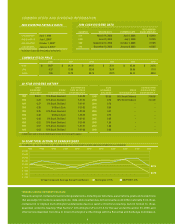Huntington National Bank 2008 Annual Report Download - page 20
Download and view the complete annual report
Please find page 20 of the 2008 Huntington National Bank annual report below. You can navigate through the pages in the report by either clicking on the pages listed below, or by using the keyword search tool below to find specific information within the annual report.would result in: (a) the recognition of additional OTTI of $64.3 million, or $0.11 per common share, and (b) a reduction to our equity
position of only $5.1 million as most of the decline in fair value would already be reflected in our equity.
Certain other assets and liabilities which are not financial instruments also involve fair value measurements. A description of these
assets and liabilities, and the methodologies utilized to determine fair value are discussed below:
Goodwill
Goodwill is tested for impairment annually, as of October 1, based upon reporting units, to determine whether any
impairment exists. Goodwill is also tested for impairment on an interim basis if an event occurs or circumstances change
between annual tests that would more likely than not reduce the fair value of the reporting unit below its carrying amount.
Impairment losses, if any, would be reflected in noninterest expense. For 2008, we performed interim evaluations of our
goodwill balances at June 30, 2008 and December 31, 2008 as well as our annual goodwill impairment assessment as of
October 1, 2008. Based on our analyses, we concluded that the fair value of our reporting units exceeded the fair value of our
assets and liabilities and therefore goodwill was not considered impaired at any of those dates.
Huntington identified four reporting units: Regional Banking, Private Financial & Capital Markets Group, Insurance, and
AFDS. The reporting units were identified after establishing Huntington’s operating segments. Components of the regional
banking segment have been aggregated as one reporting unit based upon the similar economic and operating characteristics of
the components. Although Insurance is included within the Private Financial & Capital Markets Group segment for 2008, it is
evaluated as a separate reporting unit since the nature of the products and services differ from the rest of the Private
Financial & Capital Markets Group segment. The AFDS unit does not have goodwill, and therefore, is not subject to goodwill
impairment testing.
The first step of impairment testing required a comparison of each reporting unit’s fair value to carrying value to identify
potential impairment. An independent third party was engaged to assist with the impairment assessment.
To determine the fair value of the Private Financial & Capital Markets Group and Insurance reporting units, a market
approach was utilized. Revenue, earnings and market capitalization multiples of comparable public companies were selected
and applied to the reporting units’ results to calculate fair value. Using this approach, the Private Financial & Capital Markets
Group and Insurance reporting units passed the first step, and as a result, no further impairment testing was required and
goodwill was determined to not be impaired for these reporting units.
At December 31, 2008, our goodwill totaled $3.1 billion. Of this $3.1 billion, $2.9 billion, or 95%, was allocated to Regional
Banking. To determine the fair value of the Regional Banking reporting unit, both an income (discounted cash flows) and
market approach were utilized. The income approach is based on discounted cash flows derived from assumptions of balance
sheet and income statement activity. It also factors in costs of equity and weighted-average costs of capital to determine an
appropriate discount rate. The market approach is similar to the method for the Private Financial & Capital Markets Group
and Insurance units as described above. The results of the income and market approach were weighted to arrive at the final
calculation of fair value. As market capitalization has declined across the banking industry, we believed that a heavier
weighting on the income approach was more representative of a market participant’s view. The Regional Banking unit did not
pass the first step of the impairment test, and therefore, we conducted the second step of the impairment testing. The second
step required a comparison of the implied fair value of goodwill to the carrying amount of goodwill.
The aggregate fair values were compared to market capitalization as an assessment of the appropriateness of the fair value
measurements. As our stock price fluctuated greatly during 2008, we used our average stock price for the 30 days preceding
the valuation date to determine market capitalization. The comparison between the aggregate fair values and market
capitalization indicates an implied premium. A control premium analysis indicated that the implied premium was within
range of the overall premiums observed in the market place.
To determine the implied fair value of goodwill, the fair value of Regional Banking (as determined in step one) is allocated to
all assets and liabilities of the reporting unit including any recognized or unrecognized intangible assets. The allocation is
done as if the reporting unit had been acquired in a business combination, and the fair value of the reporting unit was the
price paid to acquire the reporting unit. Key valuations were the assessment of core deposit intangibles, the mark-to-fair value
of outstanding debt, and discount on the loan portfolio. The mark adjustment on our outstanding debt is based upon
observable trades or modeled prices using current yield curves and market spreads. The valuation of the loan portfolio
indicated discounts that we believe were consistent with transactions occurring in the marketplace.
The results of this allocation indicated the implied fair value of Regional Banking’s goodwill exceeded the carrying amount of
goodwill for Regional Banking, and therefore, goodwill was not impaired.
It is possible that our assumptions and conclusions regarding the valuation of our reporting units could change adversely and
could result in impairment of our goodwill. Such impairment could have a material effect on our financial position and
results of operations.
18
Management’s Discussion and Analysis Huntington Bancshares Incorporated
























